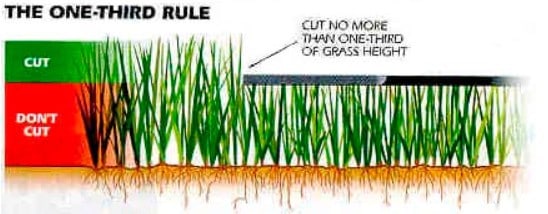In general, taller mowing heights result in healthier
grass that is better able to resist drought and limit the
occurrence of weeds. The mowing height also depends
on the turfgrass species and environmental conditions.
Four turfgrass species are primarily used in Iowa lawns and include Kentucky bluegrass, fine fescue, perennial
ryegrass, and tall fescue. Perennial ryegrass and fine
fescues can be mowed slightly shorter compared to
Kentucky bluegrass and tall fescue.
Increase the mowing height of cool-season species
during the stressful summer months. Taller mowing
heights insulate the crown of the plant against high
temperatures, provide more leaf area thereby increasing
photosynthesis, and encourage deeper root systems
to obtain more water. These practices help the lawn
withstand periodic high-temperature and drought
conditions. The height may be lowered in the fall
when the temperatures cool and more consistent
rainfall returns.
Recommended Mowing Height for Turf
The recommended lawn mowing height also reflects
cultivar differences within a species. For instance,
many common Kentucky bluegrass cultivars have more
erect growth habits compared with newer cultivars.
Similar differences also apply to perennial ryegrass
and tall fescue. For more information, refer to Iowa
State University Extension and Outreach publication
“Selecting a Grass Species for Iowa Lawns” (HORT 3023).
Mowing below the recommended range can scalp
the turf and lead to rapid deterioration of turfgrass
quality. Excessively close mowing heights
decrease the total leaf area, carbohydrate reserves, and
root growth, thereby creating a situation where plants
are unable to produce enough food to meet their own
demands. This makes the plants more susceptible to
drought, high temperature, and wear injury. In addition,
the bare areas created by a decrease in lawn density
increase the chances of weed problems.
It’s also possible that turfgrass also can be too high. Mowing above
the recommended ranges reduces tillering and causes
matting of the grass. Reduced tillering results in
fewer and coarser plants, while matted grass creates a
microenvironment that encourages disease development.
Lawn Mowing frequency as determined by the one-third rule
- Turf mowing height (inches)
- Height of grass at mowing (inches)
- Amount of grass removed (inches)
- Estimated mowing frequency (days)*
- *Estimate based upon a daily growth rate of 0.2 inches


